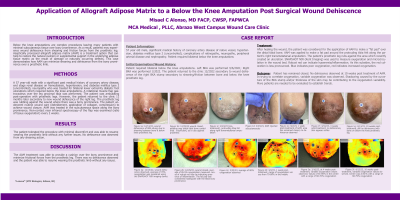Case Series/Study
(CS-005) Application Of Allograft Adipose Matrix To A Below The Knee Amputation Post Surgical Wound Dehiscence

Below the knee amputations are complex procedures leaving many patients with minimal subcutaneous tissue over bony prominence. As a result, patients may experience wound dehiscence from shearing and friction forces from the prosthetic leg. Aseptically processed allograft adipose matrix (AAM) is a treatment option that can help to restore the natural cushion or supplemental support in the underlying adipose tissue matrix as the result of damage or naturally occurring defects. This case demonstrates how AAM can minimize shearing and dehiscence from the bony prominence over a prosthetic limb.
Methods:
A 57 year-old male with a significant past medical history of coronary artery disease, end stage renal disease on hemodialysis, hypertension, and diabetes mellitus type 2 (uncontrolled), neuropathy who was treated for bilateral lower extremity diabetic foot ulcerations which required below the knee amputations. A rotational muscle flap gastrocsoleus over the leg proximal tibia was performed. The patient was ambulating post-operative with prosthetic legs. However, the patient returned to the clinic 11 months later secondary to new wound dehiscence of the right leg. The prosthetic leg was rubbing against the wound where there was a bony prominence. The patient underwent routine wound care (debridement, application of collagen, compression) to achieve wound closure. AAM was treated in the sub-cutaneous space along the bony prominence. Non-contact near infrared spectroscopy of the flap was examined (ratio of tissue oxygenation) every 2 weeks.
Results:
The patient tolerated the procedure with minimal discomfort and was able to resume wearing the prosthetic limb without any further issues. No dehiscence was observed from any shearing action.
Discussion:
The AAM treatment was able to provide a cushion over the bony prominence and minimize frictional forces from the prosthetic leg. There was no dehiscence observed and the patient was able to resume wearing the prosthetic limb without any issues.
Trademarked Items: LENEVA
References:

.png)